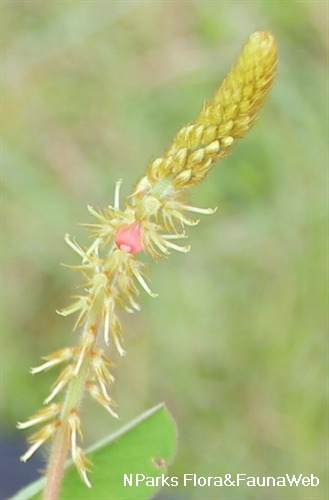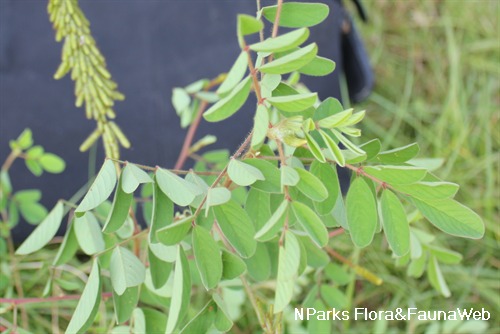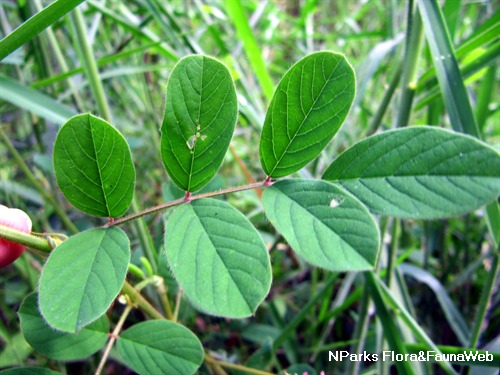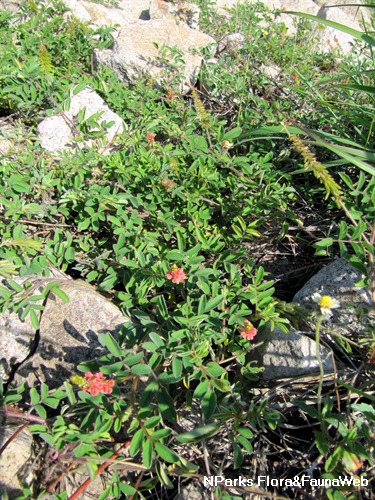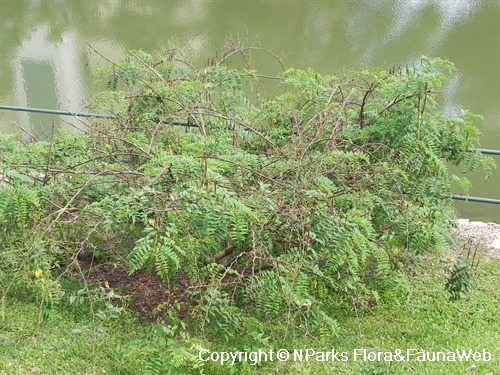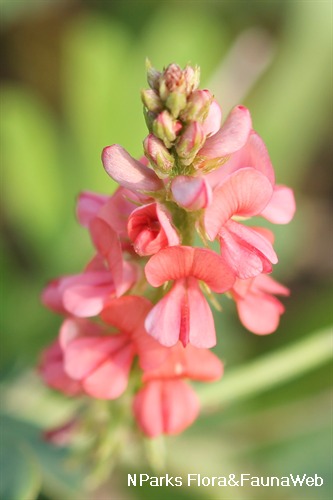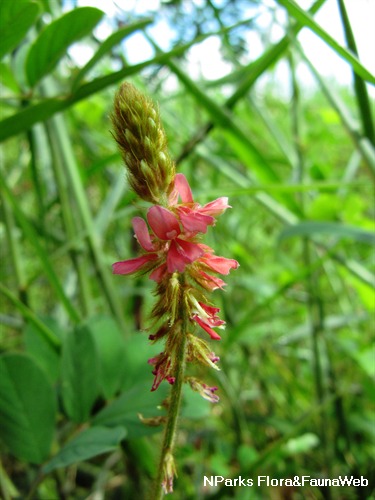
Back
Indigofera hirsuta L.
| Family Name: | Fabaceae (Leguminosae) |
| Synonyms: | Indigofera ferruginea, Indigofera fusca, Indigofera indica |
| Common Name: | Hairy Indigo, Roughhairy Indigo, 硬毛木蓝 |
Name
Classifications and Characteristics
| Plant Division | Angiosperms (Flowering Seed Plants) (Dicotyledon) |
|---|---|
| Plant Growth Form | Shrub |
| Lifespan (in Singapore) | Annual |
| Mode of Nutrition | Autotrophic |
| Maximum Height | 1.5 m |
Biogeography
| Native Distribution | Africa, Madagascar to Southern Asia, Australia |
|---|---|
| Native Habitat | Terrestrial |
| Local Conservation Status | Non-native (Spontaneous (Naturalised)) |
Description and Ethnobotany
| Growth Form | Shrublet or shrub with erect or spreading growth form, growing up to 1.5 m tall. |
|---|---|
| Foliage | Compound leaves are typically composed of 5-7 elliptic to oblong leaflets, but sometimes up to 9 leaflets (4 cm long, 2.5 cm wide). Both sides of the leaf are pilose, being covered in long, soft hairs. |
| Stems | Cylindrical stems are covered by orange-brown to reddish brown hairs. |
| Flowers | Red to pinkish red, pea-shaped flowers are densely arranged in racemes (20-30 cm long). The standard (the large upper petal of the flower) is red to pinkish red with a white spot at the middle of the base. |
| Fruit | Fruits are straight, narrow pods that are cylindrical to 4-sided (1.5-2 cm long, 2-2.5 mm wide). Pods are hirsute, being covered in stiff, brown hairs. The pods hang down in a dense chain that resembles a bottle brush. |
| Cultivation | This species grows best on moderately acidic soil, but it can also tolerate low pH soils. |
| Ethnobotanical Uses | Others: This species could be used to improve soil quality, because it grows on infertile, low pH soils. |
Landscaping Features
| Landscaping | This species is typically considered a weed. |
|---|---|
| Plant & Rootzone Preference or Tolerance Remarks | Sandy Soils |
Plant Care and Propagation
| Light Preference | Full Sun |
|---|---|
| Water Preference | Moderate Water |
| Rootzone Tolerance | Well-Drained Soils, Poor Infertile Soils, Acidic (low pH) Soils |
| Propagation Method | Seed |
Foliar
| Mature Foliage Colour(s) | Green |
|---|---|
| Mature Foliage Texture(s) | Hairy / Hirsute |
| Foliar Type | Compound (Odd-Pinnate) |
| Foliar Attachment to Stem | Petiolate |
| Foliar Shape(s) | Non-Palm Foliage (Obovate, Elliptical) |
| Foliar Venation | Pinnate / Net |
| Foliar Margin | Entire |
| Foliar Apex - Tip | Rounded |
| Foliar Base | Cuneate |
Floral (Angiosperm)
| Flower & Plant Sexuality | Bisexual Flowers |
| Flower Colour(s) | Red |
|---|---|
| Flower Grouping | Cluster / Inflorescence |
| Flower Symmetry | Bilateral |
| Individual Flower Shape | Stellate / Star-shaped |
| Inflorescence Type | Raceme |
| Flowering Habit | Polycarpic |
| Inflorescence Size | 25 cm |
Fruit, Seed and Spore
| Mature Fruit Colour(s) | Brown |
|---|---|
| Mature Fruit Texture(s) | Hairy / Hirsute |
| Fruit Classification | Simple Fruit |
| Fruit Type | |
| Mature Seed Colour(s) | Brown |
| Seed Description | Approximately cube-shaped. |
| Seed Quantity Per Fruit | Moderate (6-10) |
Image Repository
Others
| Master ID | 31569 |
|---|---|
| Species ID | 5968 |
| Flora Disclaimer | The information in this website has been compiled from reliable sources, such as reference works on medicinal plants. It is not a substitute for medical advice or treatment and NParks does not purport to provide any medical advice. Readers should always consult his/her physician before using or consuming a plant for medicinal purposes. |

